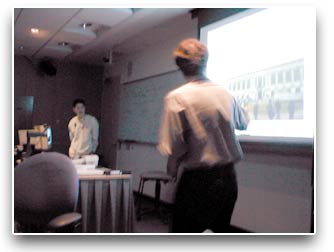
| CS 39J > Schedule & Notes > Session 3 Detailed Notes |
http://inst.eecs.berkeley.edu/~cs39j/session03.html
7 February 2002 (
)
Announcements are posted on the website! Please read
them.
We are asking your permission to post e-mail addresses so that everyone can
e-mail individual students. To e-mail the entire class, send e-mail to
cs39j-class@cory.eecs.berkeley.edu.
Topics: Students are encouraged to present a topic to the class.
Gidon Weisberg says that black & white slide film is somewhat expensive, as is its development. Prof. Barsky wonders if this is really the case relative to the professional color slide films that we have been discussing in class. Gidon also says that there are only two locations in the nation that will develop the black & white slide film. Gidon is arranging the purchase of slide film in bulk from B&H. Prof. Barsky says that B&H is reasonably-priced and reliable, with an excellent reputation.
The book Basic Photographic Materials and Processes by Leslie Stroebel et al has information about optics and chemistry. A classic book is Photography by Barbara London and John Upton. Any of the comprehensive books listed on our course website would be good references to have for those who are serious about photography.
The focal length of a normal lens is approximately the diameter of the film
you are using. 35mm film is actually 36mm by 24 mm which means that the
diagonal is about 43 mm. A black-and-white photograph of Evans Hall and
the Doe Library, taken by Gidon, was shot with a wide-angle lens. We can
determine this from the wide angle of view and the distortion in the perspective.
Choosing a focal length is an important aesthetic decision. Some professional
photographers have been known to say that they never use a normal lens since
more dramatic photographs are produced when using either a wide-angle or telephoto
lens.
Slide film has better saturation than print film. Gidon saw a table on the web compiled from statistics by manufacturers that said that print film has better resolution than slide film, but Prof. Barsky is not so sure that that is correct.
We will find out the details of this in a future class where we will have a guest lecture by a photographer who is is a Ph.D. chemist and is knowledgeable about the science of film.
Saturation can be thought of as the concentration of color and indicates how vivid the color is. The less saturated (desaturated) the color, the more gray and washed-out it is. For example, pink is a desaturated red.

 Critique
of Photographs of the Doe Library
Critique
of Photographs of the Doe LibraryProfessor Barsky now demonstrates how to load a slide into a slide tray so
that it will project in the correct orienation. Hold the slide tray so
that the numbers increase on the right towards you. Now, hold the
slide such that as you look at it, it is in the correct orientation, and then
turn it so that it is upside down and place it into the slide carousel.
A "crit" is a "critique", in art/architecture/design lingo.
We begin critiquing the photographs of the Doe Library that the students have
done for their assignment.
Lighting: Some photographyers advise avoid photographing around
noon because the light is "flat". At dusk or dawn, the light
is at an angle that results in more interesting lighting and hence provides
more interesting photographs.
Sun: In the northern hemisphere, the sun is never due north.
We may have had trouble taking good bright photographs of the Doe Library because
the sun never shines on the front of the Doe Library (especially during the
winter). Unfortunately, in photography, unlike in drawing, we are constrained
by the reality of the scene to be photographed.
Composition: Michael Bina's photograph seems to tell more of a
story. There is a lone person, with bare trees and blue hues. Michael
framed this photograph from a different perspective by simply kneeling down,
which changes the perspective signficantly.
Camera Club: In a camera club, a photographer (such as you) can
show a photograph and then all of the other members in the club "rip it
to shreds" with criticism. Be prepared to accept criticism.
If you do criticize a piece of work, try to be constructive about it.
Night Shots: When exposing for a longer period (such as at nighttime),
it is advisable to use a tripod to avoid camera shake.
Reciprocity Failure: For long exposures, the film response characteristics
change. This is called "reciprocity failure" and gives rise
to underposure. This also engenders a shift in color balance due to each
color layer of the film emulsion having a different response at slower shutter
speeds.
Computer lab accounts were distributed in class. The official forms should
be given to you within the week. Most likely you won't do anything with
the user accounts, but you are required to read these
(brief but important) policies regarding your accounts.
Mike Margolis demonstrated some Macintosh basics. We will put this information
— plus some Photoshop jumpstarts and remote login information — up on the web
as soon as we can. Check the computer labs
information page for updates in the future.
  |
|